 |
| |
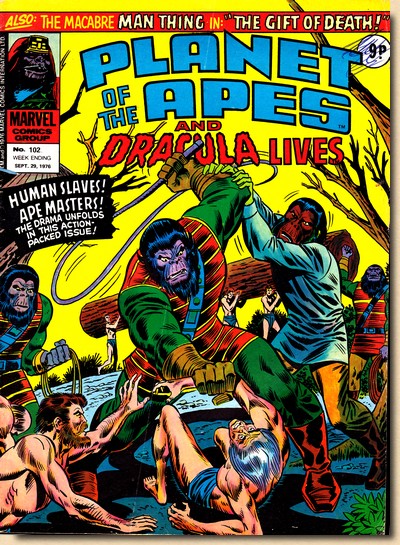 |
|
INSIDE
MARVEL UK's
PLANET OF
THE APES #102
SEPTEMBER 1976
Marvel launched its own UK
imprint operation in late September 1972 with a
comic book which would become both its flagship
title and its publication credo and motto:
the Mighty World of Marvel.
Edited in the US but printed
in the UK to a larger format than American Marvel
comic books, the 40 page Mighty World of
Marvel #1 kicked off a row of highly
successful years for what would soon be known as
"Marvel UK".
|
|
| |
| The UK
comic book market of the 1970s differed greatly from its
counterpart in the US as it was quintessentially keyed at
a weekly interval of publication, with predominantly
black and white contents and multiple storylines (and
therefore often also various different characters) in one
issue. By mid-1974, the success of Marvel
UK's first three weeklies had the powers in charge look
to further expansion, and this move would - at the height
of the popularity and importance of the horror and
fantasy genres for the US market - almost inevitably
point to additional material which would complement the
so far superhero-only publications. The move happened on
26 October 1974 when two new weeklies were launched
simultaneously: Dracula Lives! and Planet of
the Apes - the latter only two months after Marvel
had launched its venture into the franchise in the USA
with the black and white magazine format Planet of
the Apes #1.
|
| |
| Following up on the release
of the 1973 movie Battle for the Planet of
the Apes and the 1974 CBS television series,
Marvel was eager to expand into any genre and
theme which held the promise of a profitable
comic book market version, and thus launched the
series with an adaptation of the original 1968
movie starring Charlton Heston. Originally a
novel by French author Pierre Boulle (1912-1994),
La plančte
des singes was published in 1963 and
tells the uncanny story of a group of astronauts
who land on a planet which seems to be a spitting
image of the Earth save one big exception - the
status and roles of human beings and primates on
this planet are just the opposite of what they
are back home. Here, the apes shape and control
society and rule over human beings, who are
treated as an inferior species. Marvel's US
black and white Planet of the Apes ran
for a total of 29 issues and, besides adaptations
of all five movies, featured original stories
written by Doug Moench and Gerry Conway with
artwork by George Tuska, Mike Esposito, Mike
Ploog, and many others. This was the prime source
of reprint material for Marvel UK's Planet of
the Apes (as with most of the British titles
the acronym - in this case POTA - became
a household label for readers), although the
desperate need for more stories at one point even
prompted the use of Killraven stories from Amazing
Adventures #18-39 (May 1973 - November 1976)
under the name of Apeslayer - including
aliens redrawn as apes.
|
|
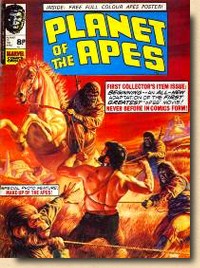
UK Planet of the Apes #1
(26 October 1974)
|
|
| |
| Issue #102 of POTA
carries the tagline "and Dracula Lives"
- a result of the cancellation of the horror title Dracula Lives!
in late June 1976 and its subsequent merger with Planet
of the Apes as of issue #88 of that title. Brought
about by the necessity to cut costs, Marvel UK stuck to
the house style of its American parent company and sold
necessity as virtue by featuring the cover headline "And
now: The long-awaited merger of Marvel's mightiest
mags!". |
| |
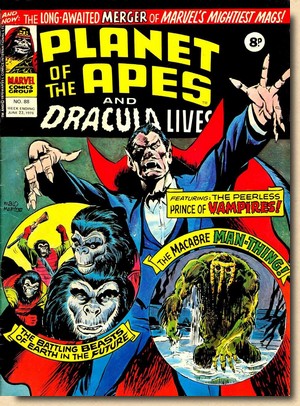
Planet of the Apes #88 merges
Dracula Lives into its pages (23 June
1976)
|
|
This line of thought was
underscored further by an introductory page in Planet
of the Apes and Dracula Lives #88 which
reached the conclusion that turning two weeklies
into one - featuring the Planet of the Apes
stories and Ka-Zar from the origional POTA
line-up and Dracula and Man-Thing from the
original cast of regulars featured in Dracula
Lives! - was "clearly consolidating
the Marvel age of comics!". The stark
reality was that by 1976 the British
comic book market found itself under the dark
clouds of a UK economy in a state of gloom and
trauma. On the heels of an inflation rate which
had climbed to 20+% in 1975 (Wanninski, 1975),
the value of the British pound sterling began to
slide during the first quarter of 1976. By
September that year confidence in the pound had
virtually collapsed, and the British government
was forced to seek help from the International
Monetary Fund - an unprecented move for a first
world country, and one which would not be seen
repeated again until the 2011/12 Euro crisis or
the near financial collapse of Greece in 2015.
Not surprisingly, the subsequent political crisis
left Britain in an even deeper state of gloom
(Burk, 1992).
Just
how difficult life had become for Marvel UK can
be glimpsed from the fact that in July 1976 even
the Avengers lost their own weekly title and were
merged
with the flagship weekly Mighty World of
Marvel - which thus gained the tagline "and
the Avengers". This was the logic
behind the usage of the word "merger",
and it became Marvel UK's fits-all approach to
adjusting the number of weekly titles to a
dwindling market.
|
|
| |
| The mergers
created an ever increasing volatility in the line-up of
characters featured in Marvel UK's weekly publications.
As the number of characters featured in one weekly rose,
the page count available to print their storylines grew
smaller, resulting in some installments cut down to as
few as four pages in one issue. This was also true
for POTA, which by September 1976 carried no less than
five different storylines in its 34 interior pages. So
let's take a closer look at the black and white content
behind the glossy cover of Planet of the Apes #102,
which went on sale in the UK the last week of 29
September 1976.
|
| |

"Quest
for the Planet of the Apes -
Part I: Seeds of Future Deaths"
Originally published
in Planet of the Apes #22 (July
1976)
Original
story title: "Quest for the Planet
of the Apes - Part I:
Seeds of Future Deaths"
Script - Doug
Moench
Pencils - Rico Rival
Inks - Rico Rival
Original page count:
18
Reprinted pages:7
|
|
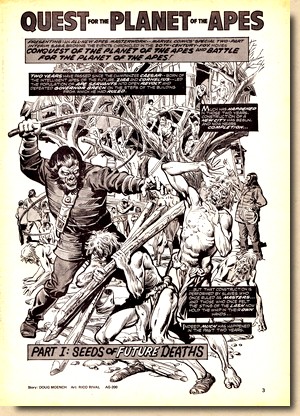
|
|
|
| |
| Quest
for the Planet of the Apes is an
original storyline penned by Doug Moench
for Marvel's Planet of the Apes
Magazine, linking up the fourth and the
fifth movies (Conquest of the Planet
of the Apes and Battle for the
Planet of the Apes, adaptations of
which also appeared in the same title).
The intention was to bridge the gap
between the two movies and build a deeper
continuity. Marvel already had
plenty of experience juggling around the Planet
material and readers were used to the
comics differing from the movies here and
there, not the least as Marvel's
adaptations were based on the shooting
scripts rather than the actual movies.
A year after
the ravages of a nuclear war, a new
community of apes has formed who followed
Caesar, their leader, out of "the
city" following a revolt and after
taking a number of humans as prisoners to
act as a work force. Caesar is a moderate
and harbours concerns regarding the
mistreatment of humans at the hands of
apes, which earns him continuous and
growing accusations of being a traitor to
the cause of the apes from his rival,
Aldo. In a quest to determine leadership,
Aldo challenges Caesar to journey back to
the human city they left - and whoever
brings back the "best thing"
shall rule. Although knowing full well
the dangers of entering the scene of
nuclear warfare, Caesar is forced to
accept, even though others urge him not
to go...
|
|
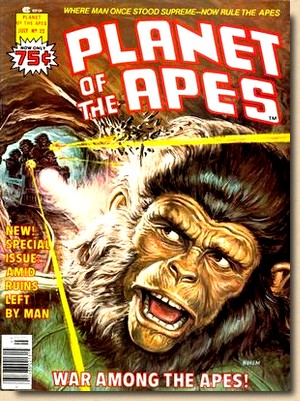
US Planet of the
Apes Magazine #22
(July 1976)
|
|
|
| |
| The
Planet of the Apes material reprinted by
Marvel UK differs from their other features in
that the source material itself was only
published in black and white in the US. The
reason for this - to keep a rather long story
short - was Marvel's drive to expand their market
base at the outset of the 1970s. One way of doing
this was to publish more and more comic book
titles (which they did, tapping into genres other
than superheroes, such as horror, sword &
sorcery or martial arts). Another approach was to
enter the field of magazine format comics, which
did not fall under the scrutiny of the Comics
Code Authority and therefore often featured
stronger content both in terms of stories and
artwork (i.e. moderate
profanity, partial nudity, and more graphic
violence). While the page count of
these comic magazines could vary between 68 and
84 pages, their contents were invariably black
& white and predominantly featured horror,
fantasy and science fiction material. The comic
magazines published by the House of Ideas didn't
carry the Marvel Comics brand (not until late in
the 1970s, that is) but ran under the imprint of
Curtis (taken from Curtis Circulation, Marvel's
distributor), shortened to CC as of 1975 (i.e.
the same as featured in the issue number boxes of
the regular Marvel comic books). In essence,
Marvel was attacking Warren Publishing (of Vampirella
fame) who dominated the comics magazine market,
but in spite of the contributions of writers such
as Doug Moench, Roy Thomas, Marv Wolfman and
Archie Goodwin, the magazines never really
fulfilled the promises Marvel perceived. In
comparison to the competitors' titles, Marvel's
comic magazines often never quite made it off the
ground and many were cancelled before reaching
two digit number issues. As was often the problem
with Marvel in the 1970s, a lot less effort went
into keeping titles afloat than into launching
them. The efforts of the editorial
team for the first segment of POTA #102 were
similarly lacking as they quite simply forgot to
add any kind of pointer to the next issue in the
final panel of this installment...

|
|
| |

"Into
the Lair of the Lizard Men!"
Originally published
in Ka-Zar #12 (November
1975)
Original
story title: "Wizard of Forgotten
Flesh"
Script - Doug
Moench
Pencils - Russ Heath
Inks - Russ Heath
Lettering - Joe Rosen
Original page count:
18
Reprinted pages: 6 (plus Marvel UK splash
page)
|
|
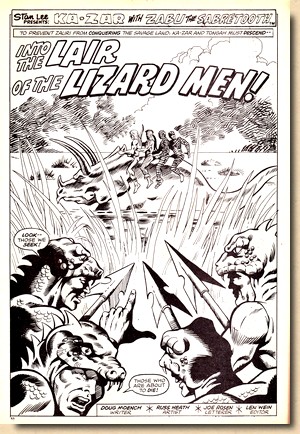
|
|
|
| |
| Starting out with one
of the many extra splash pages produced
by Marvel's NYC staff for Marvel UK, this
example illustrates how these pages were
increasingly set up to avoid an all too
abrupt entry for readers into what was in
fact a mere segment of an original flow
of events - as opposed to simply blowing
up the final page panel from last week's
installment (as had been the standard
Marvel UK practice in 1973 and 1974).
Often inspired, however, by a preceding
single page panel, they were generally
unsigned - and of varying quality. In
this case, the New York based staffer had
redrawn a panel (rather than just
producing a stat and pasting it up) while
turning it around 180 degrees and adding
a group of "lizard men" in the
foreground. |
|
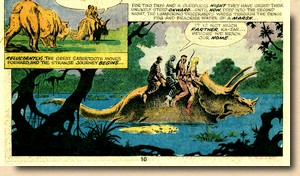
|
|
|
| |
| Having
Ka-Zar in the pages of POTA made sense, given that he is
Timely Comics' 1940's copycat Tarzan, was revived by Stan Lee
and Jack Kirby for X-Men #10 in March 1965, and
has a history with "Man-Apes". Ka-Zar is actually Kevin Reginald
(Lord) Plunder, the eldest son of the English explorer
Lord Robert Plunder who discovered the "Savage
Land", a mysterious place underneath Antarctica
which he found to be populated by several human or
humanoid tribes as well as dinosaurs and other wild
species. Following the death of his mother and the
killing of his father by the barbaric Man-Ape natives of
the Savage Land, Kevin Plunder was found and raised by
the sabretooth tiger Zabu, who possesses near-human
intelligence thanks to a mutation caused by
"radioactive mists".
|
| |
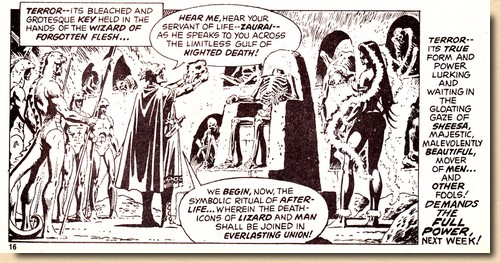 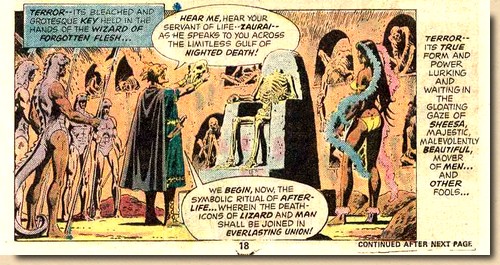
|
|
Taking
on the name of Ka-Zar (meaning "Son
of the Tiger" in the language of the
Man-Apes) he becomes an expert in living
off the wild land and acts as an
unofficial general protector of the
Savage Land, preventing outside
commercial exploitation and at the same
time enforcing peace between the various
tribes and serving as a goodwill
ambassador to friendly visitors - the
first of which were the original X-Men. The story partially
reprinted here comes from his second (of
a total of four) own ongoing series which
ran for a total of twenty issues between
1974 and 1977.
The 18 pages
of an original US issue were commonly
split up over three weekly UK issues, and
here readers get the middle part of
"Wizard of Forgotten Flesh",
which features the mysterious lizard men
clan with their wizard and an even more
mysterious female power monger called
Sheesa.
Sometimes,
Marvel UK editorial was quite simply
lucky - as in this case, where the final
panel of the installment left more than
ample room to add an additional line of
exposition to point readers to next
week's installment of Ka-Zar in POTA.
|
|
|
| |
| In the case of this issue's
Ka-Zar material, Russ Heath's artwork seemed to have
rather more umph than the Planet of the Apes material.
The man from the Savage Land and his sabretooth companion
had been a part of the lineup of Marvel UK's Planet
of the Apes since issue #2. Adding some original
Marvel material to the Planet adaptations, Ka-Zar
reinforced POTA's non-superhero character. As such, it
was probably either hit or miss for
"traditional" Marvel readers, but as with Star
Wars it was above all the large fan community which
came away from the movies that bought POTA and kept it
going for so long. |
| |

"...Once
More A Man!"
Originally published in Man-Thing
(Vol. 1) #8 (August
1974)
Original story
title: "The Gift of Death!"
Script - Steve Gerber
Pencils - Mike Ploog
Inks - Mike Ploog
Lettering - Artie Simek
Original
page count: 18
Reprinted pages: 3 (plus Marvel UK splash/intro
page)
|
|
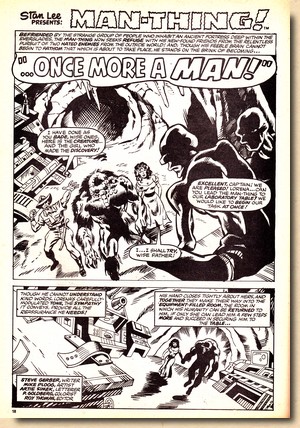
|
|
| |
| The
economically forced mergers of various
Marvel weeklies resulted in more features
per title with less pages each for their
respective storylines. Things were
starting to get a little cramped in
Marvel UK's titles in late 1976, as the
the Man-Thing installment featured in
POTA #102 serves to illustrate. Man-Thing
was the feature, together with Dracula,
which was continued from Dracula
Lives! when Marvel UK's horror
themed weekly merged with Planet of
the Apes. Marvel's muck monster (conceived by Stan Lee
and Roy Thomas in late 1970 and fleshed
out by Gerry Conway and Gray Morrow in
1971) had made its Marvel
UK debut in issue #63 of Dracula
Lives! in January 1976, when
Marvel UK ran out of Living Mummy
material - as was likely to happen, given
the weekly publication schedule of what
sometimes was original material from a
bi-monthly only cycle in the US.
This problem - which
quickly haunted all of Marvel UK's
weeklies - was slowed down a bit when the
"merger weeklies" happened, but
really all that the UK editorial crew got
was simply a different kind of headache
as they now sometimes had to shrink a
weekly installment to a page count which
hardly allowed the story to move on in a
sensible way for readers. The only saving
grace was the fact that British comic
book readers were actually used to such a
setup and hence more forgiving than one
can imagine today.
|
|
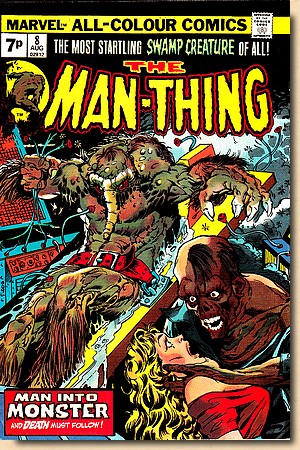
|
|
|
| |
| But
then they simply had to be, in cases such as this, where
the Man-Thing feature pointed readers to next week's
issue of POTA after a mere four pages - a featurette
at best. |
| |
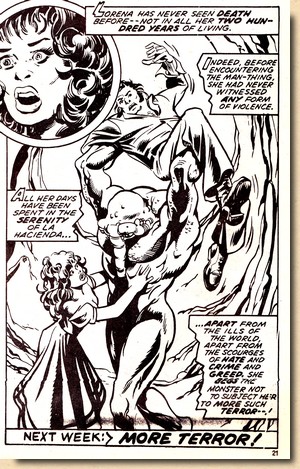 |
|
Such a
dissection called for an even larger number of
splash pages especially produced for the Marvel
UK weeklies, as features with lower page counts
also required some form of story recap to provide
at least some minimal structure for the
readership. For
POTA #102, this resulted in a two panel page
which was more like an additional story page than
an actual splash page. For obvious reasons, this
material was never credited, but some general
information did pop up now and then in the
bulletin pages of the Marvel UK weeklies.
"Adorable
ED HANNIGAN and Mischievous MIKE ESPOSITO,
long time workers on these books, have been
teaming up on covers drawn especially for the
British editions of THE PLANET OF THE APES!
And while we're on the subjects of covers, we
might as well throw in the name of PABLO
MARCOS, who's been doing most of our DRACULA
LIVES frontispieces!" (Marvel UK Bullpen
Bulletin, 16 November 1974)
Marcos had a long standing
involvement with Marvel UK covers, but interior
artwork was sometimes seemingly also handed to UK
staffers, George Mina being one of them.
|
|
| |
| The segment of the
Man-Thing story originally featured in Man-Thing (Vol. 1)
#8 (August 1974) really is too abrievated to be recapped
here, but interestingly enough it had been available to
readers in the UK previously, in late summer 1974, in its
original form, as Man-Thing #8 had been prodcued and
exported to Britain by Marvel as a UK pence price variant. |
| |

"Gorgolla!
The Living Gargoyle!"
Originally published in Strange
Tales #74 (April 1960)
Original story
title: "Gorgolla! The Living
Gargoyle!!"
Script - Larry Lieber
(plot by Stan Lee)
Pencils - Jack Kirby
Inks - Dick Ayers
Lettering - Artie Simek
Original
page count: 7
Reprinted pages: 7 (plus Marvel UK splash page)
|
|
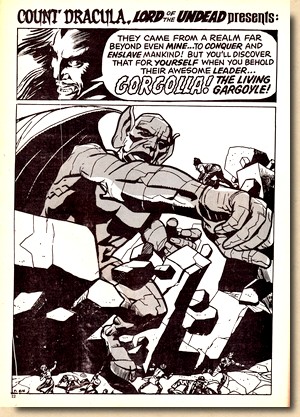
|
|
| |
| Almost as though Marvel UK
wanted to offer readers at least one entire full
length reprint of original US material, the Dracula
Lives feature offered an old Stan Lee and
Jack Kirby monster yarn instead of the usual Tomb of
Dracula material. While this did
provide readers not only with a full length but
also a self-contained done-in-one story, these
late 1950s and early 1960s "reprint
fillers" were never hugely popular with
readers. It was, however, a convenient way for
editorial to catch their breath once in a while
with the Dracula material as the count was
reduced to a first page banner reading COUNT
DRACULA, LORD OF THE UNDEAD, presents: - in
this case Gorgolla, the Living Gargoyle, a
typical specimen of the gallery of monsters drawn
by Kirby and labelled with double consonant-heavy
names by Stan "the Man". 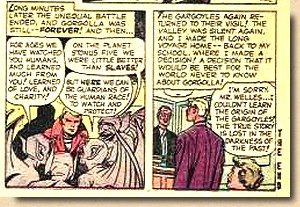 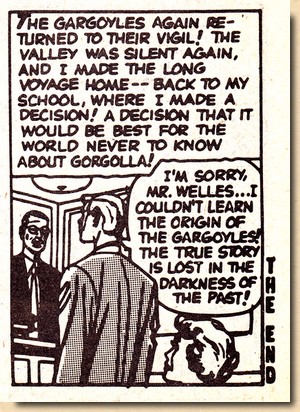
|
|
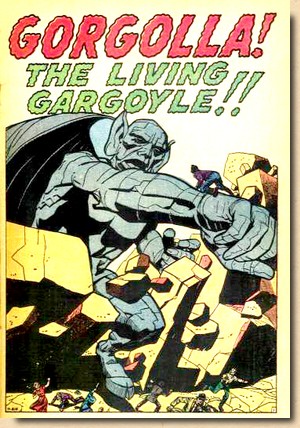
|
|
| |
| No
editorial touchup other than the initial banner itself
was needed, and these monster stories were indeed printed
without any alterations as such. Following this fourth
feature in POTA #102 there was even a fifth waiting for
readers - a return, so to speak, to the Planet of the
Apes...
|
| |

"...Run
for Your Life!"
Originally published
in Planet of the Apes #3 (December
1974)
Original
story title: "Manhunt"
Script - Doug
Moench
Pencils - George Tuska
Inks - Mike Esposito
Original page count:
20
Reprinted pages:6
|
|
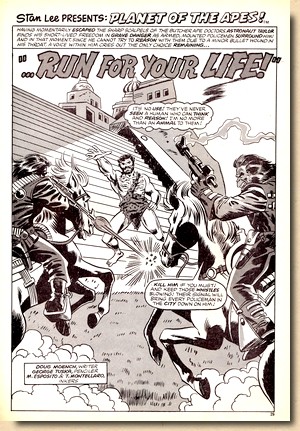
|
|
|
| |
| Coming
from the very early issues of the US
comic magazine Planet of the Apes,
the story reprinted in part here is a
part of an original storyline arc penned
by Doug Moench and pencilled and inked by
Marvel stalwarts George Tuska and Mike
Esposito. Having two Planet of
the Apes features in one issue of POTA
made things even more cramped than they
would already have been with four
different feature segments, but the
Planet material was simply deemed too
successful to do with less.
Successful
comic book adaptations such as Star
Wars and Planet of the Apes
allowed Marvel to tap into a reader
segment which it normally would not reach
with its original (predominantly
superhero) material. Marvel UK thus had
to carefully balance out things when it
merged such a title as POTA, and the
result was that the Simians continued to
play a predominant role even after Planet
of the Apes merged with Dracula
Lives. The covers alone gave a clear
indication of who was running this
weekly: with less than a handful of
exceptions, they would always feature the
apes from POTA.
Even the
indicia hinted at this, as it stated that
the material contained in this comic was
based upon "the widely
acclaimed" series of motion
pictures commencing with The Planet
of the Apes from 1967 - a completely
unnecessary appraisal which made the
House of Ideas look like it was even
blowing its marketing trumpet in what
commonly is the most technical and matter
of fact text segment in any publication.
|
|
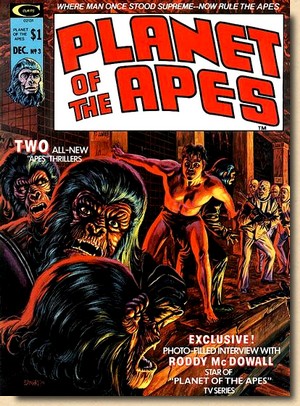
US Planet of the
Apes Magazine #3
(December 1974)
|
|
|
| |
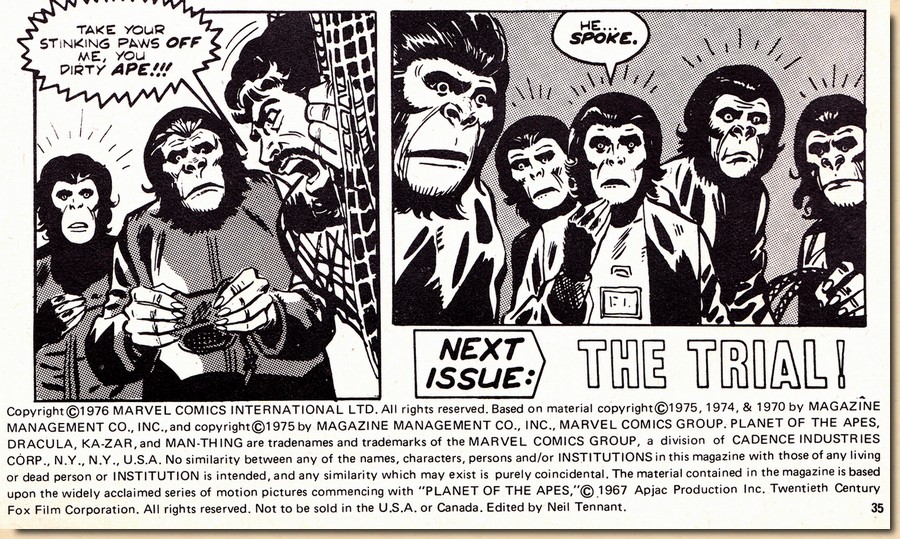 |
| |
| POTA #102
was so filled to the brim with reprint material that
there simply was no room to publish any editorial
material such as a bullpen bulletin - other issues were
somewhat less crowded and also ran a letters page aptly
titled "Ape's Fang Mail". But for issue #102,
the only in-house material was a 5/6 page advertisement
for Super Spider-Man
with the Super-Heroes #190. As the title
clearly states, this was another weekly resulting from a
merger - and, as can be seen from the ad, one of two
which Marvel UK published in landscape format for a while
(the other being The Titans). |
| |
 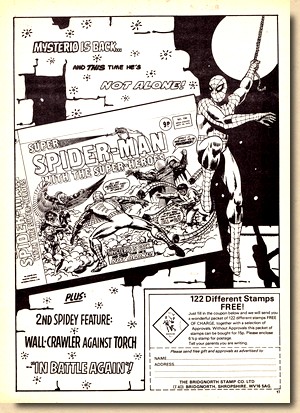 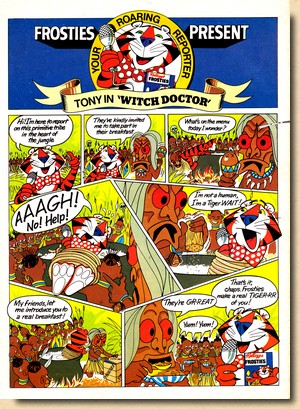 |
| |
| Other than that, readers
got a full colour advert (on the back cover) for
Kellogg's Frosties which by today's standards is probably
somewhat lacking in PC, and the almost standard plastic
model kit advert (on the inside front cover) although
this time for a brand made in Italy. The Planet of the Apes franchise was
a huge success for Marvel, both in the US and as a weekly
in the UK. POTA ran for a total of 123 issues from late
October 1974 to late February 1977 when it, too, was
merged with another Marvel UK weekly, the flagship Mighty World of
Marvel (#231, 2 March 1977). However, only three
months later, in mid-June 1977, Marvel UK dropped the
Savage Simians from its line completely after their last
appearance in Mighty World of Marvel #246 - not
the least due to the fact that Marvel UK had, quite
simply, run out of material to reprint (Kirby, 2011).

More on
Marvel UK in 1976:
1975
- 1977 : EXPANSION, MERGERS - AND CAPTAIN BRITAIN !
|
| |
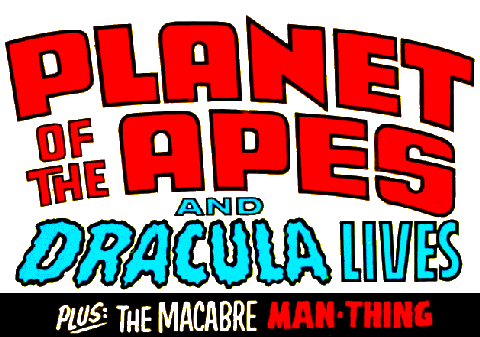
|
| |
|
| |
| BIBLIOGRAPHY BURK
Kathleen (1992) Goodbye, Great Britain: The
1976 IMF Crisis, Yale University Press
KIRBY
Robin (2011) personal communication
KIRBY Robin
(2013) "The Mighty World of Marvel UK", in Back
Issue #63, April 2013
SANDERSON
Peter (1998) Marvel Universe, Abrams
WANNINSKI
Jude (1975) "Goodbye,
Great Britain", The Wall Street Journal (April
29 1975 issue)
|
| |
Uploaded
to the web 1 December 2015
Text is copyright (c) 2015

|
|
| |































